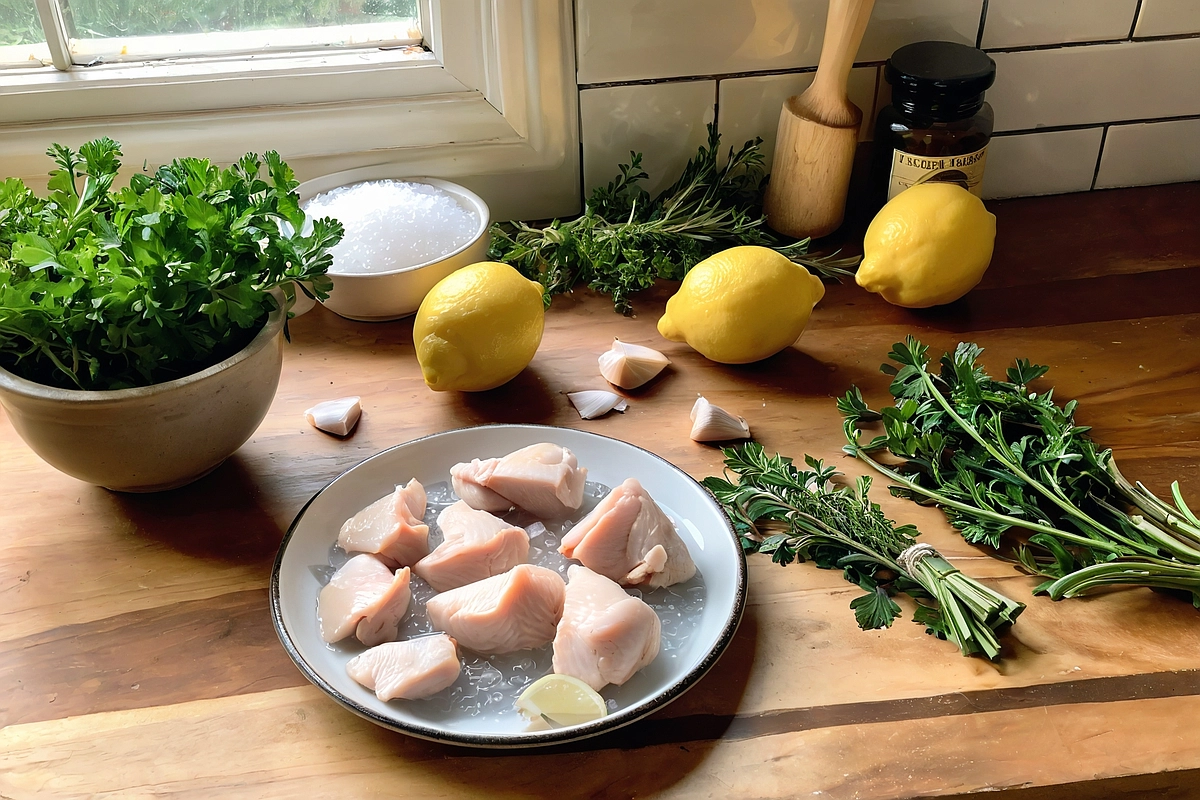If you’ve ever wondered, “What is the simple brine formula for chicken?” you’re not alone! Brining is a classic cooking technique that enhances the flavor and juiciness of chicken, making it a favorite method for both home cooks and professional chefs. In this guide, we’ll explore everything you need to know about creating a simple chicken brine, including the best ingredients, ratios, and methods to ensure your chicken turns out perfect every time.
Understanding Brine and Its Components
What is a Chicken Brine?
A solution of water, salt, and sugar tenderizes and flavors the chicken meat. When you immerse chicken in this solution, it absorbs the salty liquid, which helps to break down the proteins and retain moisture during cooking. This process makes the meat incredibly juicy and flavorful, even after roasting, grilling, or frying.
Brining has been a staple in culinary traditions for centuries. For a detailed guide on achieving the perfect brine, check out our ultimate guide to chicken brine which explores different methods and ingredients. A simple brine formula for chicken usually includes basic ingredients like kosher salt, water, and a touch of sugar. Optional elements such as herbs, spices, and citrus fruits can also be added to enhance the flavor profile.
Why Brine Chicken?
Brining chicken is an excellent way to enhance the meat’s natural flavors while keeping it moist and tender. The process works by using the salt in the brine to penetrate the chicken’s muscle fibers, drawing water into the cells and helping the chicken retain its moisture during cooking.
Unlike marinating, which primarily adds flavor to the surface, brining affects the chicken all the way through. This makes it especially effective for roasting or grilling, where the intense heat can easily dry out the meat. By using a simple brine formula for chicken, you ensure every bite is juicy, tender, and bursting with flavor.
Difference Between Brine and Marinade
While both brines and marinades are used to enhance the flavor of meat, there are some key differences. Brines are primarily saltwater solutions that focus on moisture retention and tenderness, while marinades usually contain an acidic component, like vinegar or lemon juice, which tenderizes the meat and adds flavor to the surface.
Brining is best for maintaining moisture and improving texture, whereas marinating is excellent for adding bold, surface-level flavors. If your goal is to achieve a juicy and flavorful chicken throughout, sticking with a simple brine formula for chicken is the way to go.
Simple Brine Formula for Chicken
Basic Brine Ingredients
A basic chicken brine includes three main ingredients: water, kosher salt, and sugar. For more variations and ideas, visit our article on what is the simple brine formula. The water acts as the base, the salt helps break down muscle proteins and retains moisture, and the sugar balances the saltiness while promoting caramelization during cooking.
To add depth and complexity to your brine, consider experimenting with fresh herbs, spices, and even unique ingredients found in our guide on how to cook purple sweet potatoes for an unexpected twist. These elements infuse the chicken with subtle layers of flavor, enhancing the overall taste.
Basic Ratio for Chicken Brine
The foundational ratio for a simple brine formula for chicken is 1 cup of kosher salt to 1 gallon of water. For added sweetness and a touch of caramelization, you can include ½ cup of sugar per gallon of water. This balance ensures that the chicken absorbs the brine without becoming overly salty or sweet.
The brine should be mixed thoroughly until the salt and sugar are completely dissolved. For additional flavor, you can add herbs, spices, or even explore unique ideas like those found in our guide on creative sourdough discard recipes. Allow the brine to cool completely before using it to avoid partially cooking the chicken when it’s immersed.
How to Make a Simple Brine for Chicken
- Prepare the Brine Solution: In a large container, combine 1 gallon of water with 1 cup of kosher salt and ½ cup of sugar. Stir until the salt and sugar are completely dissolved.
- Add Flavor Enhancers: Optional – Add herbs like thyme or rosemary, spices like peppercorns, or slices of citrus fruits to the brine.
- Cool the Brine: Ensure the brine has cooled to room temperature or lower before adding the chicken. Ensure the brine has cooled completely before adding the chicken to avoid affecting the texture.
- Submerge the Chicken: Place the chicken in the brine, ensuring it is fully submerged. Use a weight if necessary to keep it underwater.
- Refrigerate: Let the chicken sit in the brine in the refrigerator for the recommended time (see next section).
Best Practices for Brining Chicken
How Long to Brine Chicken?
The duration of brining depends on the size and type of chicken cut. Here’s a quick guide to help you:
- Whole Chicken: Brine for 8 to 24 hours. Overnight brining is ideal for deep flavor penetration.
- Chicken Breasts: Brine for 1 to 2 hours. The shorter brining time helps maintain moisture while preventing the chicken from becoming overly salty. For more tips on preparation, learn how to perfectly cook chicken breasts.
- Chicken Thighs and Drumsticks: Brine for 2 to 4 hours. Darker meat cuts benefit from longer brining to enhance tenderness.
- Chicken Wings: Brine for 1 to 2 hours. Brining wings helps retain moisture and improves flavor.
Optimal Brining Methods
- Storage Tips: Always brine your chicken in the refrigerator to maintain optimal conditions. Use a large, food-safe container or resealable plastic bag that allows the chicken to be fully submerged.
- Ensuring Full Coverage: Make sure the chicken is completely covered by the brine. Use a heavy plate or a specialized brining bag to keep the chicken submerged.
Tips for Successful Brining
- Use Kosher Salt: Avoid table salt, which is finer and denser. Kosher salt dissolves better and is less likely to over-salt your chicken.
- Measure Carefully: Maintain the correct salt-to-water ratio for the best results. Too much salt can make the chicken too salty.
- Allow the Chicken to Rest: After brining, allow the chicken to rest briefly at room temperature before cooking to ensure even flavor distribution.
Enhancing Your Chicken Brine
Adding Flavor to Your Brine
To elevate the simple brine formula for chicken, consider adding complementary ingredients or pairing your meal with something from our sourdough bagels guide for a complete culinary experience. Fresh herbs like rosemary, thyme, and parsley add earthy, aromatic notes. Citrus fruits such as lemons and limes contribute a bright, tangy flavor, while spices like black peppercorns, garlic, and bay leaves add complexity.
By experimenting with different combinations, you can customize your brine to suit any dish, from a classic roast chicken to a spicy grilled variation.
Alternative Ingredients for Chicken Brine
If you’re looking to experiment further, try incorporating other ingredients:
- Honey or Maple Syrup: Substitute sugar with these natural sweeteners for a different flavor profile.
- Soy Sauce: Adds a savory, umami element to the brine.
- Fresh Ginger and Garlic: Enhances the depth of flavor and complements other seasonings.
Quick Brine Options for Busy Days
When time is limited, opt for a quick brine. Smaller cuts, like chicken breasts or thighs, can be brined in as little as 30 minutes to 1 hour. For this, use a concentrated brine with a slightly higher salt content, such as 1½ cups of kosher salt per gallon of water. Quick brines are perfect for weeknight meals when you need to add flavor and moisture in a hurry.
Preparing Chicken After Brining
Rinsing and Drying Chicken Post-Brine
Once you have finished brining, remove the chicken from the brine solution and rinse it under cold running water. This step removes excess salt from the surface to balance the flavor. Pat the chicken dry with paper towels to help achieve a crispy skin when cooking.
Cooking Methods for Brined Chicken
There are several cooking methods that work well for brined chicken:
- Roasting: Perfect for whole chickens or larger cuts. Roast at high heat to develop a crispy, golden-brown skin while keeping the meat moist.
- Grilling: Great for adding a smoky flavor. Grill over medium heat to cook evenly without drying out.
- Frying: Ideal for chicken pieces like wings or drumsticks. The brine keeps the meat juicy even after deep-frying.
Adjust the cooking times according to the chicken’s size and thickness to cook it thoroughly while keeping it juicy.
FAQs about Chicken Brine
What is the formula for brining chicken?
The basic formula for brining chicken involves dissolving 1 cup of kosher salt in 1 gallon of water, with an optional addition of ½ cup of sugar. Herbs, spices, or citrus can be added for extra flavor.
What is the basic ratio for brining?
A standard ratio is 1 cup of salt per gallon of water. You can also add ½ cup of sugar for a balanced flavor.
What is the ratio of salt and sugar in brine?
Typically, the ratio is 1 cup of kosher salt to ½ cup of sugar per gallon of water. Adjust according to your taste preferences and the desired level of sweetness or saltiness.
What is the best chicken brine percentage?
The ideal salt concentration for brining chicken is around 5-10%, depending on the level ofcooking satisfaction.
Conclusion
Brining is a simple yet highly effective technique for enhancing the flavor and moisture of chicken. By using the right ingredients and maintaining the correct ratios, you can achieve a juicy, flavorful dish every time. The simple brine formula for chicken, with a base of water, salt, and sugar, provides a perfect foundation to which you can add herbs, spices, and other ingredients for extra flavor. Whether you’re a seasoned cook or a beginner, incorporating brining into your cooking routine will elevate your chicken dishes to new heights.
By following these guidelines and experimenting with different ingredients, you can make your chicken dishes juicier and more flavorful every time!


2 thoughts on “What is the Simple Brine Formula for Chicken? Find Out Here!”